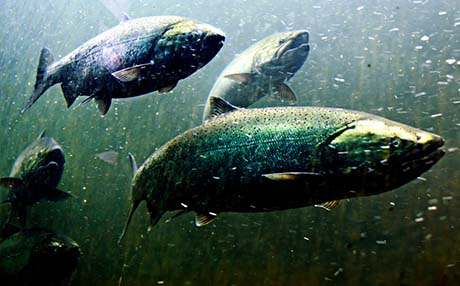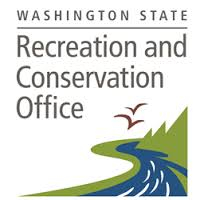State Board Awards $21 Million in Grants to Aid Salmon Recovery
Posted September 24, 2021 at 5:45 am by Tim Dustrude

Salmon swimming upstream to spawn – Richard Lawrence photo

OLYMPIA–The Washington State Salmon Recovery Funding Board today announced the award of $21 million in grants across the state to aid in salmon recovery.
The grants, given annually, went to 105 projects in 29 of the state’s 39 counties. The grants will pay for work to restore salmon habitat, including repairing degraded habitat in rivers, removing barriers blocking salmon from reaching the ocean, and conserving pristine habitat.
“Salmon are important to every Washingtonian, whether they spend time fishing, eat salmon, rely on salmon for their business or use salmon in their cultural celebrations,” said Gov. Jay Inslee. “It’s imperative that we improve the areas salmon need, and these grants help do that.”
Descriptions of Grants
Grants were awarded in the following counties. Click below for details on each project:
- Asotin County…………………… $200,000
- Chelan County………………….. $813,982
- Clallam County……………….. $1,181,390
- Clark County…………………….. $295,796
- Columbia County……………….. $437,575
- Cowlitz County………………….. $990,342
- Garfield County…………………. $145,500
- Grays Harbor County………….. $481,837
- Island County……………………. $467,723
- Jefferson County……………….. $887,750
- King County……………………… $659,869
- Kitsap County…………………… $449,985
- Kittitas County…………………… $970,044
- Klickitat County…………………. $602,859
- Lewis County……………………. $177,734
- Mason County…………………… $907,485
- Okanogan County…………… $1,248,018
- Pacific County………………… $1,940,420
- Pend Oreille County…………… $483,250
- Pierce County…………………… $983,062
- San Juan County……………….. $308,602
- Skagit County…………………. $1,263,141
- Skamania County………………. $442,114
- Snohomish County………….. $1,318,813
- Thurston County………………… $373,434
- Wahkiakum County……………… $79,000
- Walla Walla County……………. $862,616
- Whatcom County……………….. $743,103
- Yakima County………………….. $343,156
- Multiple Counties…………….. $1,023,338
The grant recipients also invest in salmon recovery and will be contributing more than $19.2 million in matching resources, such as staff labor, donations, or equipment use.
Why Are Salmon in Trouble?
As Washington’s population grew, the number of salmon dwindled. By the end of the twentieth century, the numbers of wild salmon and steelhead had dropped so much that the federal government declared species in nearly three-fourths of the state as threatened or endangered. The Legislature created the Salmon Recovery Funding Board in 1999 to determine how best to distribute state and federal funding to recovery projects.
“This funding provides the foundation for efforts to protect and restore the habitat our salmon and steelhead depend upon,” said Jeff Breckel, chair of the Salmon Recovery Funding Board. “It supports the work of many dedicated individuals and organizations and leverages additional government and private funding. These grants are one of our best tools for reversing the decline of salmon populations. Without this funding, we simply wouldn’t be able to save salmon, which are such a critical part of our Northwest culture, economy and quality of life.”
Why is Recovery Important?
Salmon are a keystone species upon which many other animals rely. One report documented 138 species of wildlife, from whales to flies, that depend on salmon for their food. Salmon fishing also is important to Washington’s economy. Commercial and recreational fishing in Washington is estimated to support 16,000 jobs and $540 million in personal income. Recreationally, an estimated $1.5 billion is spent annually on fishing and harvesting shellfish in Washington, supporting many rural families and businesses. In addition, Washington State is obligated to uphold treaty-reserved fishing rights for Indian tribes and has a duty to ensure salmon are present and available for harvest.
Investing in salmon recovery also helps local businesses. Every $1 million spent on forest and watershed restoration generates between 15.7 and 23.8 jobs. About 80 percent of that funding stays in the county where the project is located. Overall, salmon recovery funding since 1999 has resulted in more than $1 billion in economic activity.
How Projects are Chosen
“Washington has a unique approach to salmon recovery,” said Megan Duffy, director of the Washington State Recreation and Conservation Office, which provides support to the salmon board. “The local community decides which projects are important to them and to salmon. That process helps ensure we are funding projects local communities will embrace and help support. Salmon recovery would be less effective if communities weren’t involved.”
Projects are selected by lead entities, which are watershed-based groups that include tribes, local governments, nonprofit organizations and citizens. The projects are based on federally approved, regional salmon recovery plans. Lead entities vet projects through citizen and science committees. The projects then are reviewed by regional organizations and submitted to the Salmon Recovery Funding Board for funding. Regional salmon recovery organizations and the board review each project for cost-effectiveness and to ensure they will benefit salmon.
You can support the San Juan Update by doing business with our loyal advertisers, and by making a one-time contribution or a recurring donation.
Categories: Animals, Environment, Government, Wildlife










No comments yet. Be the first!
By submitting a comment you grant the San Juan Update a perpetual license to reproduce your words and name/web site in attribution. Inappropriate, irrelevant and contentious comments may not be published at an admin's discretion. Your email is used for verification purposes only, it will never be shared.